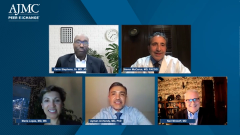
Common Conditions During Reproductive Years
Ayman Al-Hendy, MD, PhD and Maria Lopes, MD, MS discuss common concerns that women seek care for during their reproductive years, including uterine fibroids, endometriosis, and unintended pregnancy.
Episodes in this series

Neil Minkoff, MD: Hello, and welcome to this AJMC® program: “Managed Care Perspectives: Optimizing Women’s Reproductive Health.” I’m Neil Minkoff, the chief medical officer at Coeus Healthcare and Consulting [in Sudbury, Massachusetts]. Joining me for this discussion are a number of my colleagues: Dr Maria Lopes, the chief medical officer at AMC Health [in New York, New York]; Dr Kevin Stephens, the regional chief medical officer for employer and individual accounts at UnitedHealth Group [in New Orleans, Louisiana]; Dr Ayman Al-Hendy, a professor of OB-GYN at the University of Chicago; and Dr Steven McCarus, the chief of gynecologic surgery at AdventHealth [in Kissimmee, Florida].
We’ll have our panel of experts provide an overview of the burden of common health concerns in women’s reproductive years, review the available treatment options, and discuss personalized treatment approaches for women’s reproductive health. Let’s begin.
In this first section, we’re going to talk a little about the overview of the different considerations in women’s reproductive health: unintended pregnancy, heavy menstrual bleeding, uterine fibroids, endometriosis, and so on. I’ll ask Dr Al-Hendy, 1 of our clinical experts, to start this conversation. What are the common conditions with which women are seeking care from folks like yourself during their reproductive years, especially among some of those things that I already listed?
Ayman Al-Hendy, MD, PhD: Neil, you listed very common conditions in women in their premenopausal reproductive years. Roughly from mid to late teens to menopause are the reproductive years, with the average age of menopause being 52. The most common conditions are uterine fibroids and endometriosis, and heavy menstrual bleeding is a common denominator between those 2. I’d probably add adenomyosis to that also. We’ll probably talk more about that later. Unintended pregnancy is also there. These are very common conditions.
If you look at the prevalence of uterine fibroids, by age 50, up to 70% of white women will have suffered from uterine fibroids, and 80% of women of color will have suffered from or had some element of uterine fibroids. Endometriosis is still very common. It’s much less common but still very common. About 10% to 15% of reproductive age women suffer from endometriosis.
These are extremely common conditions. Many of them present with a common symptom, heavy menstrual bleeding, whether the periods are fairly regular or quite heavy. Or the patient could come in and say, “Instead of my usual 4 to 5 days, now I’m bleeding much longer.” Or they try to quantify that the bleeding is getting heavier per day or in the form of irregular bleeding. Some patients would say, “I get my regular period, but I have another period a week or 10 days later.” Some patients say, “I’m bleeding nonstop for the whole month on and off.” A common symptom for all these disorders is pelvic pain and pelvic discomfort, probably more on the endometriosis side, but still with uterine fibroids and adenomyosis. These are extremely common disorders. We’ll talk later about the different risk factors.
Neil Minkoff, MD: Let me ask you a quick follow-up question. Of these women who are menstruating and having the issues you’re describing, would you say most of the care is taking place in the office, in the clinic, at a Planned Parenthood, in the ED [emergency department]? How do the attempt to get medical services break down as far as you can tell from your practice?
Ayman Al-Hendy, MD, PhD: If you look nationally at the numbers, the clinic is probably the most common place where many of these patients end up. Much of the time, they go to the primary care doctor first. Because these are extremely common disorders, many patients prefer and find it easier to go to their primary care doctor.
Because the mainstay of treatment of fibroids, endometriosis, and adenomyosis has traditionally been surgery, once the diagnosis is confirmed, it was almost immediate referral to the specialist and subspecialist because there was probably surgery in the future of those patients. We’ll talk later about some of the newer medical treatment options that are very simple to prescribe and counsel your patient. We already see some of that, but I’m hoping with time, we’ll see more of these conditions being handled effectively and safely at the primary care doctor level, and maybe even by the nurse practitioner, physician assistant, and so on. Maybe only complicated cases—cases that fail medical treatment—will be referred if surgery is needed.
Because these disorders sometimes aren’t addressed effectively, many patients unfortunately end up in the emergency department. For example, uterine fibroids cause heavy menstrual bleeding. If this isn’t effectively treated, they end up with severe iron deficiency anemia. Some patients come to the emergency department with a hemoglobin of 3 or 4 g/dL, and they’re almost in shock because they’ve been bleeding for months without at least being encouraged to take iron supplements or getting effective treatment.
It’s the same thing with endometriosis and severe pain. If the patient doesn’t get reliable, effective treatment, sometimes the pain is so severe that they end up in the emergency department. We see those patients come to the emergency department and then eventually in the clinic. But these are typically elective diseases that can be effectively addressed in the clinic. Hopefully we’ll talk about these new treatment options, and hopefully we’ll see fewer ED visits with those disorders.
Transcripts edited for clarity.
Newsletter
Stay ahead of policy, cost, and value—subscribe to AJMC for expert insights at the intersection of clinical care and health economics.






























































